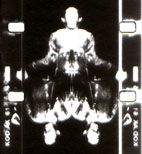Black and White Trypps Number Four
- Ben Russell |
- 2008 |
- 10.5 minutes |
- B&W |
- OPT
Rental Format(s): 16mm film
"Jesus Christ, look at the white people, rushing back. White people don't care, Jack..."
- Richard Pryor
"And so, in Black and White Trypps Number Four, we find Russell working with a processed film strip of Pryor in action. The opening minutes have Pryor in unmanipulated audio, discussing the white people in his audience, poking fun at the awkwardness with which we have made a place for ourselves. This audio is presented, appropriately enough, over clear leader. Russell shows us pockmarks, dents and scratches on the celluloid, interrupting the smooth self-evident invisibility of white projector light. Then, for the rest of the film, Russell produces high abstraction from close-up images of Pryor performing on stage. The black and white contrast is made absolute, and Russell mirrors the footage against a vertical axis down the center of the frame, producing undulating Rorschach blots, out of which Pryor's hands and visage periodically emerge. At the start, this maneuver is silent. But by the four-minute mark, Russell has reintroduced sound. Audience noise rises and falls, sounding like airstrip noise, while a black pyramid shape flaps against the frameline. (Appropriately, at the 7.5 minute mark, Russell shows the edge of the stage, which resembles an airplane wing. In between, of course, there is the usual skull-like / cricket-head blobbery.) The impact is striking; as with true abstraction, the representational image becomes subsumed within a purely formal play, and it entails a struggle on the part of the viewer to retain focus on Pryor as a stable image inside the film. In this respect, Russell has brought his phenomenological concerns regarding audienceship to an ideal crisis point. The audience for experimental film and the audience for Pryor's work may or may not intersect, but we can certainly agree that these groups have attached to them, fairly or not, certain demographic assumptions -- raced ones, classed ones, ones based on demeanor as an audience member, etc. At the crux of these difference is the very Kantian aestheticized gaze that Russell continually stages and subverts with Pryor's image and voice. Black and White Trypps Number Four enacts the distance, but is not nearly as distant as we've grown accustomed to, even by the standards of someone like Sharits, whose films do indeed grab one by the throat. By the end, Pryor has defeated abstraction, or at least reached a detente with it. (Compare Pryor's star turn with the fates of Barbara Hershey or Eli Wallach in the Tscherkassky oeuvre for stark comparison.) Russell literally gives the comedian the last word: "What're you taking my picture for? Who you gonna show it to? Who gives a fuck?"
- Michael Sicinski, The Academic Hack


